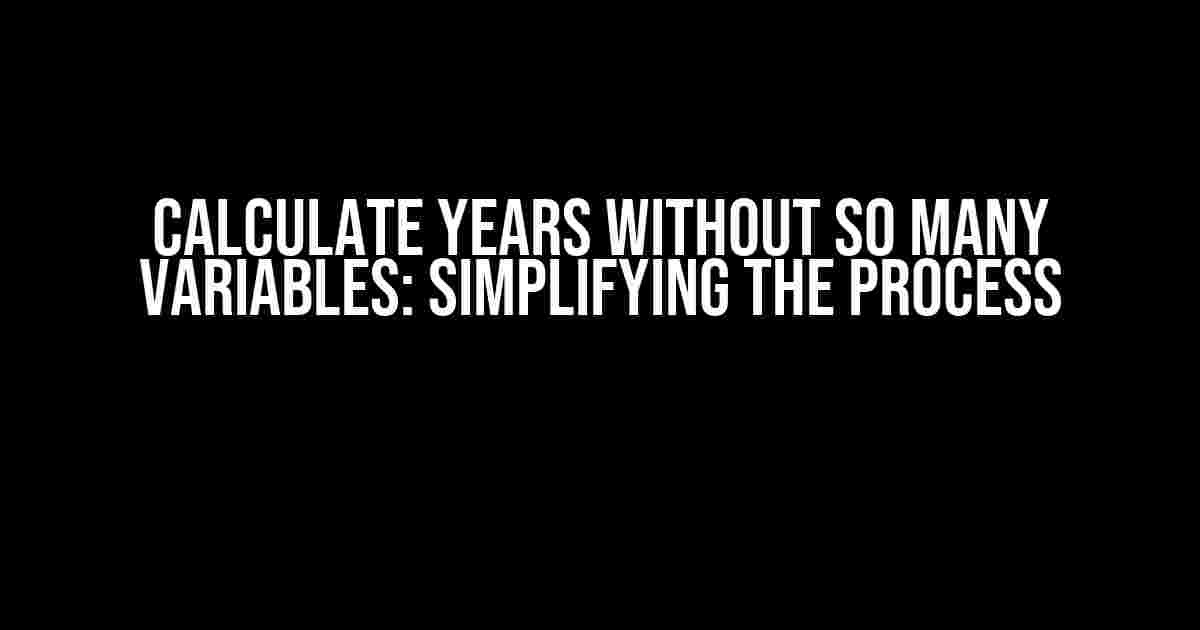Welcome to our guide on calculating years without getting bogged down in a sea of variables! In this article, we’ll show you how to simplify the process and get accurate results with ease. Whether you’re a math whiz or a struggling student, we’ve got you covered.
Why So Many Variables?
In mathematics, variables are used to represent unknown values or quantities. However, when it comes to calculating years, having too many variables can make the process confusing and overwhelming. Think about it: you’ve got dates, ages, durations, and so on. It’s no wonder people get frustrated and give up!
The Problem with Traditional Methods
Traditional methods of calculating years often involve complex formulas and equations. These might include:
- The age-old (pun intended) formula:
(End Year - Start Year) + 1 - More complicated expressions like:
(End Date - Start Date) / 365.25
These formulas might work, but they can be tricky to apply, especially when dealing with different date formats, leap years, and other exceptions.
A Simpler Approach
What if we told you there’s a better way? A way that eliminates the need for multiple variables and complex calculations? Say hello to our simplified method!
Step 1: Identify the Problem
Before we dive into the solution, let’s define the problem:
You want to calculate the number of years between two dates.
That’s it! No fancy variables or convoluted equations. Just two dates and a desire to find the number of years between them.
Step 2: Use a Simple Formula
Here’s the magic formula:
Years = (End Year - Start Year)
Yes, you read that right! Just subtract the start year from the end year, and you’ll get the number of years. No need to worry about dates, months, or even days.
Step 3: Handle Edge Cases
Of course, there are some edge cases to consider:
- Leap years:
If (End Year % 4 == 0) then Years += 1 - Same year, different dates:
If (End Date >= Start Date) then Years -= 1
These adjustments ensure accuracy and account for any anomalies.
Real-World Examples
Let’s put our simplified method to the test with some real-world examples:
| Example | Start Date | End Date | Years |
|---|---|---|---|
| Person’s Age | 1995-02-12 | 2023-02-12 | 28 |
| Project Duration | 2018-01-01 | 2025-06-30 | 7 |
| Historical Event | 1945-05-08 | 2020-05-08 | 75 |
In each example, we’ve applied our simplified formula and handled edge cases as needed. The results speak for themselves!
Conclusion
In conclusion, calculating years without so many variables is absolutely possible. By using our simplified method, you can eliminate the need for complex formulas and focus on getting accurate results. Remember:
- Identify the problem: Calculate years between two dates
- Use the simple formula:
Years = (End Year - Start Year) - Handle edge cases: Leap years, same year, different dates
With these steps, you’ll be calculating years like a pro in no time!
So, the next time you need to calculate years, ditch the variables and simplify the process. Your math skills (and sanity) will thank you!
Here are 5 Questions and Answers about “Calculate years without so many variables” in a creative voice and tone:
Frequently Asked Questions
If you’re struggling to tame the beast of complex calculations, fear not! We’ve got you covered with these simple yet effective ways to calculate years without getting bogged down by too many variables.
Can I calculate years without using formulas?
Absolutely! You can calculate years by simply counting the number of years that have passed between two specific dates. For example, if you want to know how many years are between 2010 and 2020, you can simply count 10 years.
How do I calculate years when there’s a leap year involved?
When dealing with leap years, simply remember that a leap year has 366 days instead of the usual 365. So, if you’re calculating years across a leap year, add an extra day to your count.
Can I use a calculator to make things easier?
Of course! A calculator can be your best friend when calculating years. Simply enter the start and end dates, and the calculator will do the rest for you. You can also use online date calculators or apps to make it even simpler.
How do I calculate years when the dates are in different centuries?
When dealing with dates in different centuries, simply calculate the years within each century separately and then add them up. For example, if you want to know the number of years between 1950 and 2050, calculate the years within the 20th century (1950-2000) and then add the years in the 21st century (2000-2050).
Can I use a timeline to visualize my calculations?
Yes, creating a timeline can be a great way to visualize your calculations and ensure you’re getting the correct answer. Write down the start and end dates, and then mark off each year in between. This can help you identify any errors or miscalculations.

